Mustard Gold in the Oleninskoe Gold Deposit, Kolmozero–Voronya Greenstone Belt, Kola Peninsula, Russia
Abstract
1. Introduction
2. Geological Setting of the Oleninskoe Deposit
3. Materials and Methods
4. Results
5. Discussion
6. Conclusions
Author Contributions
Funding
Acknowledgments
Conflicts of Interest
References
- Lindgren, W. Mineral Deposits; McGraw-Hill Book Company, Inc.: New York, NY, USA; London, UK, 1933; 930p. [Google Scholar]
- Nekrasov, I.Y. Geochemistry, Mineralogy, and Genesis of Gold Deposits; Routledge: Moscow, Russia, 1991; 302p. (In Russian) [Google Scholar]
- Litvinenko, I.S.; Shilina, L.A. Hypergene new formations of gold in placer deposits in the Nizne–Myakitsky placer-ore field, north-East Russia. Ores Met. 2017, 1, 75–90. (In Russian) [Google Scholar]
- Petersen, S.B.; Makovicky, E.; Juiling, L.; Rose-Hansen, J. Mustard gold from the Dongping Au–Te deposit, Hebei province, People’s Republic of China. N. Jb. Miner. Mh. 1999, 8, 337–357. [Google Scholar]
- Gamyanin, G.N.; Zhdanov, Y.Y.; Nekrasov, T.Y.; Leskova, N.V. “Mustard” gold from gold–antimony ores of Eastern Yakutia. New Data Miner. 1987, 34, 13–20. (In Russian) [Google Scholar]
- Okrugin, V.M.; Skilskaya, E.; Etschmann, B.; Pring, A.; Li, K.; Zhao, J.; Griffiths, G.; Lumpkin, G.R.; Triani, G.; Brugger, J. Microporous gold: Comparison of textures from nature and experiments. Am. Mineral. 2014, 99, 1171–1174. [Google Scholar] [CrossRef]
- Tolstykh, N.D.; Vymazalova, A.; Tuhý, M.; Shapovalova, M. Conditions of formation of Au–Se–Temineralization in the Gaching ore occurrence (Maletoyvayam ore field), Kamchatka, Russia. Mineral. Mag. 2018, 82, 1–44. [Google Scholar] [CrossRef]
- Tolstykh, N.D.; Palyanova, G.A.; Bobrova, O.V.; Sidorov, E.G. Mustard gold of the Gaching Ore Deposit (Maletoyvayam Ore Field, Kamchatka, Russia). Minerals 2019, 9, 489. [Google Scholar] [CrossRef]
- Kudaeva, A.L.; Andreeva, E.D. Mustard gold: Characteristics, types, and chemical composition. In ‘Natural Environment of Kamchatka’, Proceedings of the XIII Regional Youth Scientific Conference, Petropavlovsk, Russia, 15 April 2014; Institute of volcanology and seismology, Far-East Branch of RAS: Petropavlovsk, Russia, 2014; pp. 17–30. (In Russian) [Google Scholar]
- Parfyonov, M.I. Spongy and ‘Mustard’ Gold in the Tumannoe Gold–Antimony Deposit (Eastern Chukotka, Russia). Available online: http://www.minsoc.ru/viewreports.php?id=1&cid=1383&rid=1740 (accessed on 24 October 2019). (In Russian).
- Amuzinsky, V.A.; Anisimova, G.S.; Zhdanov, Y.U.A.; Ivanov, G.S.; Koksharsky, M.G.; Nedosekin, Y.D.; Polyansky, P.M. Sarylahskoe and Sentachanskoe Gold-Antimony Deposits: Geology, Mineralogy, and Geochemistry; MAIK ‘Nauka/Interperiodika’: Moscow, Russia, 2001; 218p. (In Russian) [Google Scholar]
- Zhao, J.; Pring, A. Mineral Transformations in Gold–(Silver) Tellurides in the Presence of Fluids: Nature and Experiment. Minerals 2019, 9, 167. [Google Scholar] [CrossRef]
- Makovicky EMartin Chovan, M.; Bakos, F. The stibian mustard gold from the Kriváň Au deposit, Tatry Mts., Slovak Republic. N. Jahrb. Miner. Abh. 2007, 184, 207–215. [Google Scholar]
- Dill, H.G.; Weiser, T.; Benhardt, I.R.; Kilibarda, R. The composite gold—Antimony vein deposit at Kharma (Bolivia). Econ. Geol. 1995, 90, 51–66. [Google Scholar] [CrossRef]
- Kalinin, A.A. Gold in Metamorphic Complexes of the North-Eastern Part of the Fennoscandian Shield; Federal Research Centre ‘Kola Science Centre’: Apatity, Russia, 2018; 250p. (In Russian) [Google Scholar]
- Kalinin, A.A.; Kazanov, O.V.; Bezrukov, V.I.; Prokofiev, V.Y.u. Gold Prospects in the Western Segment of the Russian Arctic: Regional Metallogeny and Distribution of Mineralization. Minerals 2019, 9, 137. [Google Scholar] [CrossRef]
- Volkov, A.V.; Novikov, I.A. The Oleninskoe gold sulfide deposit (Kola peninsula, Russia). Geol. Ore Depos. 2002, 44, 361–372. [Google Scholar]
- Galkin, N.N. Geology and Mineralogy of Gold Occurrences in the Pellaphk–Oleninsky Ore Unit. Ph.D. Thesis, Kola Sci. Centre, Apatity, Russia, 2006; 22p. (In Russian). [Google Scholar]
- Kudryashov, N.M.; Lyalina, L.M.; Apanasevich, E.A. Age of rare metal pegmatites from the Vasin Myl’k deposit (Kola region): Evidence from of U–Pb geochronology of microlite. Dokl. Earth Sci. 2015, 461, 321–325. [Google Scholar] [CrossRef]
- Nemčok, M.; Henk, A.; Gayer, R.A.; Vandycke, P.; Hathaway, T.M. Strike-slip fault bridge fluid pumping mechanism: Insights from field-based palaeostress analysis and numerical modeling. J. Struct. Geol. 2002, 24, 1885–1901. [Google Scholar] [CrossRef]
- Kalinin, A.A.; Savchenko, Y.E.; Selivanova, E.A. Minerals of precious metals in the Oleninskoe gold deposit (Kola peninsula). Zap. RMO 2017, 146, 43–58. (In Russian) [Google Scholar]
- Kalinin, A.A. Composition of arsenopyrite as an indicator of conditions of formation of mineralization in metasomatic rocks in the Voron’ya tundra area. In Metamorphism and Metamorphic Ore Genesis in the Early Precambrian; KFAN SSSR: Apatity, Russia, 1984; pp. 54–57. (In Russian) [Google Scholar]
- Ivashchenko, V.I.; Golubev, A.I. Gold and Platinum of Karelia: Genetic Types of Mineralization and Prospects; Runkvist, D.V., Ed.; Karelian Sci. Centre RAS: Petrozavodsk, Russia, 2011; 369p. (In Russian) [Google Scholar]
- Kalinin, A.A.; Prokofiev, V.Y.; Telezhkin, A.A. Composition of hydrothermal fluids in the gold occurrences of the Kola region. In Physico-Chemical Parameters of Petro- and Ore Genesis, Proceedings of the All-Russian Conference, Moscow, Russia, 7–9 October 2019, Electronic Edition ed; IGEM RAS: Moscow, Russia, 2019; pp. 74–76. (In Russian) [Google Scholar]
- Zhao, J.; Bruger, J.; Gundler, P.V.; Xia, F.; Chen, G.; Pring, A. Mechanism and kinetics of a mineral transformation under hydrothermal conditions: Calaverite to metallic gold. Am. Mineral. 2009, 94, 1541–1555. [Google Scholar] [CrossRef]
- Pal’yanova, G.A.; Kolonin, G.R. Geochemical mobility of Au and Ag during hydrothermal transfer and precipitation: Thermodynamic simulation. Geochem. Int. 2007, 45, 744–757. [Google Scholar] [CrossRef]
- Pal’yanova, G.A. Physico-Chemical Features of Behavior of Gold and Silver in the Processes of Hydrothermal Ore Genesis; Siberian Branch of Russian Academy of Science: Novosibirsk, Russia, 2008; 221p. (In Russian) [Google Scholar]
- Kalinin, A.A.; Savchenko, Y.E. Thallium mineralization in the Oleninskoe gold prospect, Kolmozero–Voronya belt. Proc. Fersman Sci. Sess. 2019, 16, 240–244. (In Russian) [Google Scholar] [CrossRef]
- Korobushkin, I.M.; Glotov, A.M.; Vasilkova, N.A. Character of oxidation of gold–sulfide deposits and methods of processing of the oxidized ores. Izv. Tomsk. Polytech. Inst. Probl. Geol. Gold Depos. 1977, 239, 239–248. (In Russian) [Google Scholar]
- Savva, N.E. Mineralogy of Silver in the North-East of Russia; Sidorov, A.A., Ed.; Triumph: North–East Interdisciplinary Scientific Research Institute: Magadan, Russia, 2018; 544p. (In Russian) [Google Scholar]
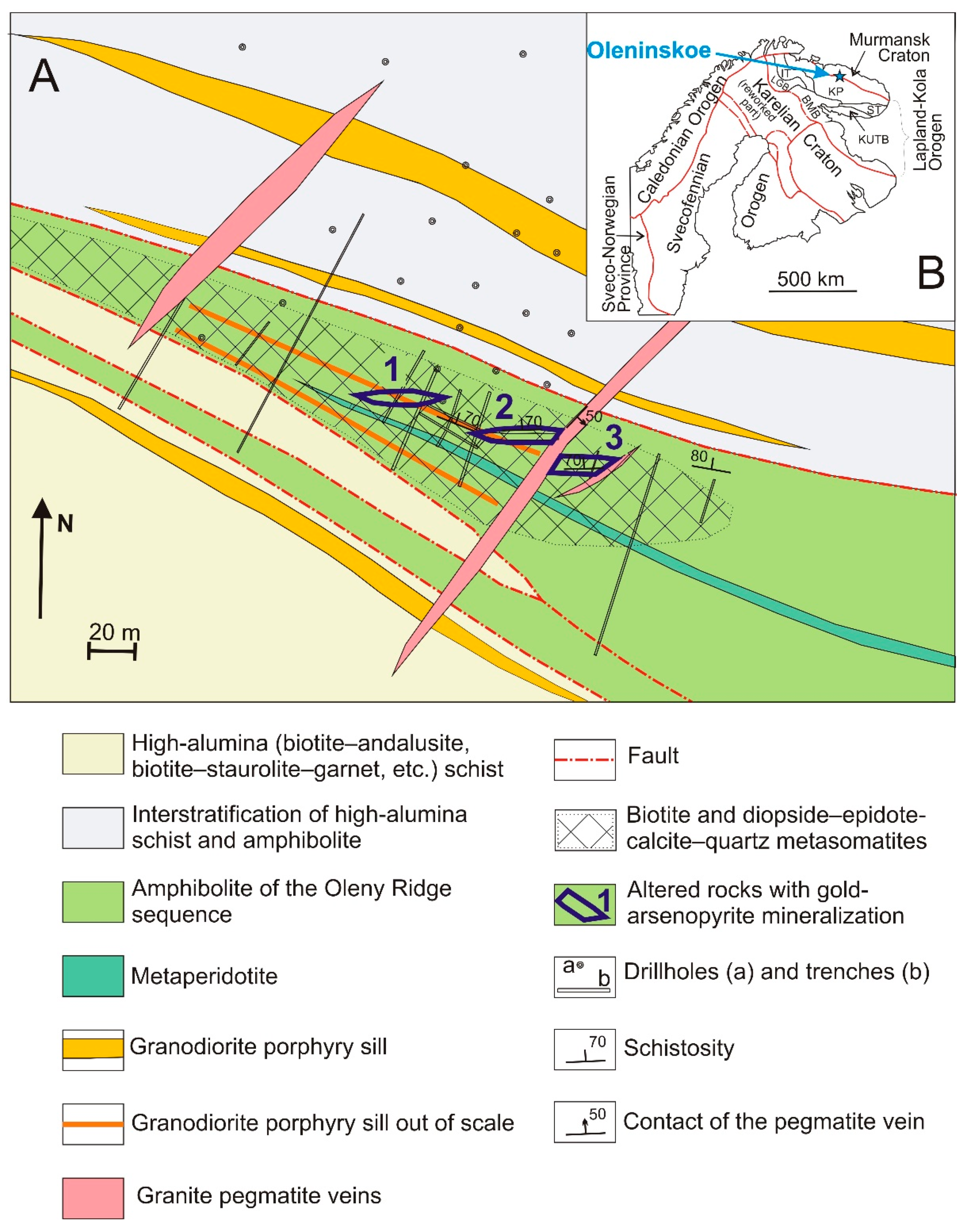

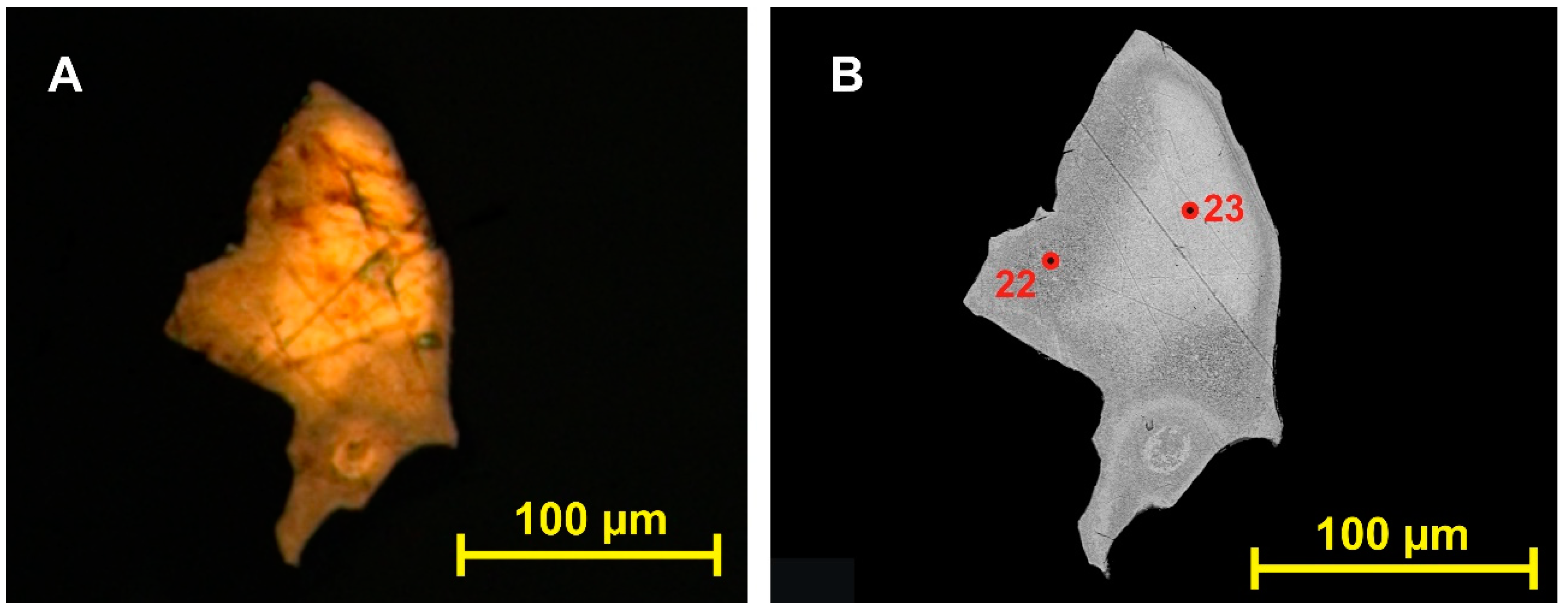
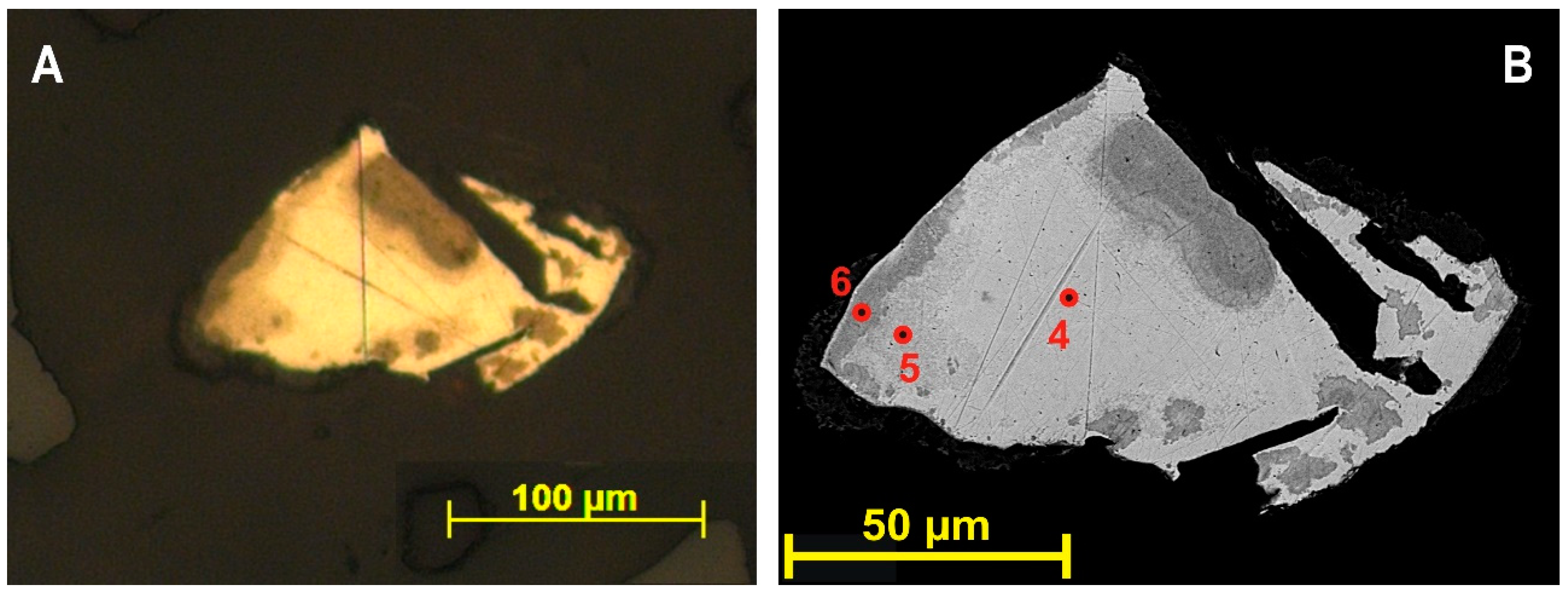
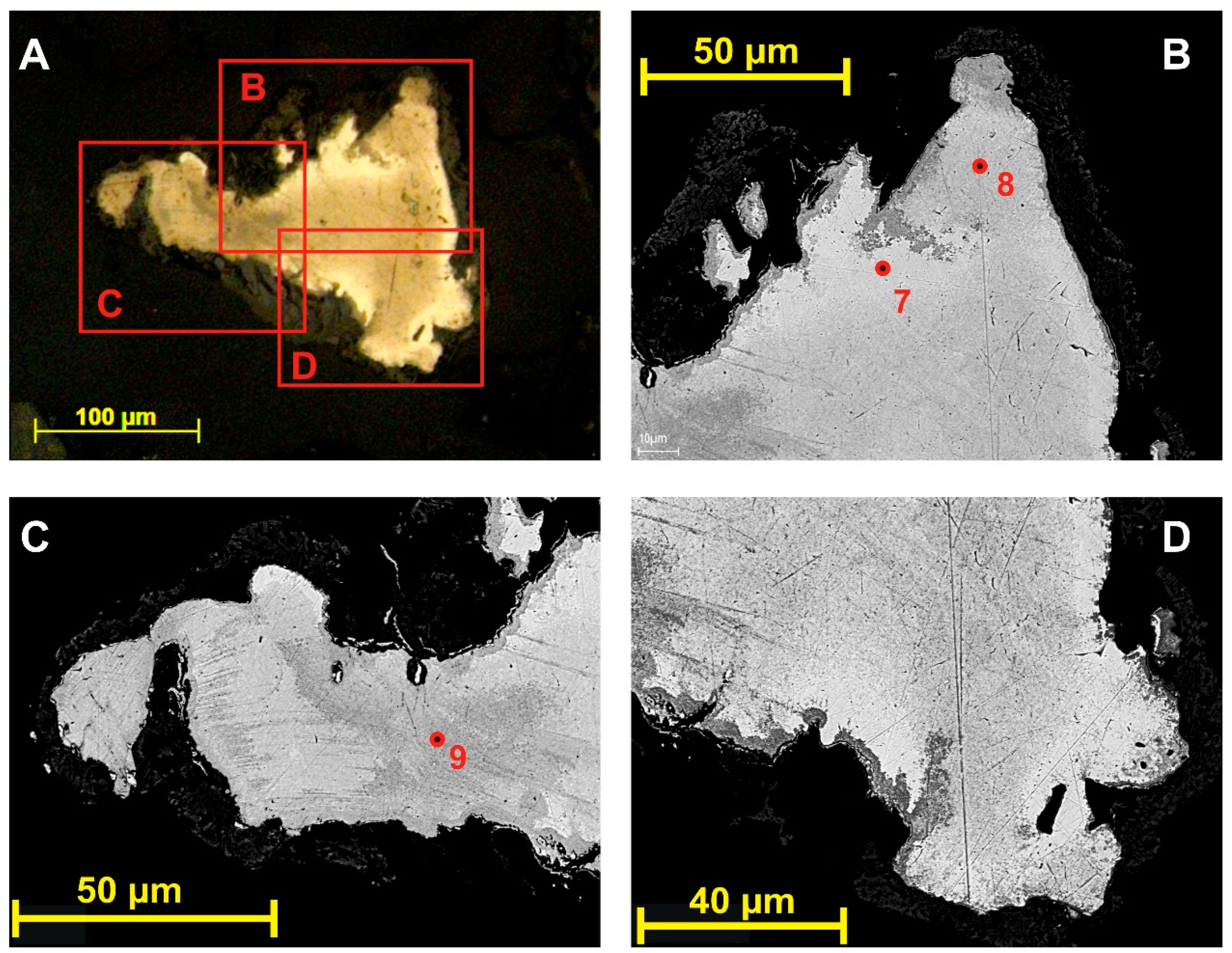
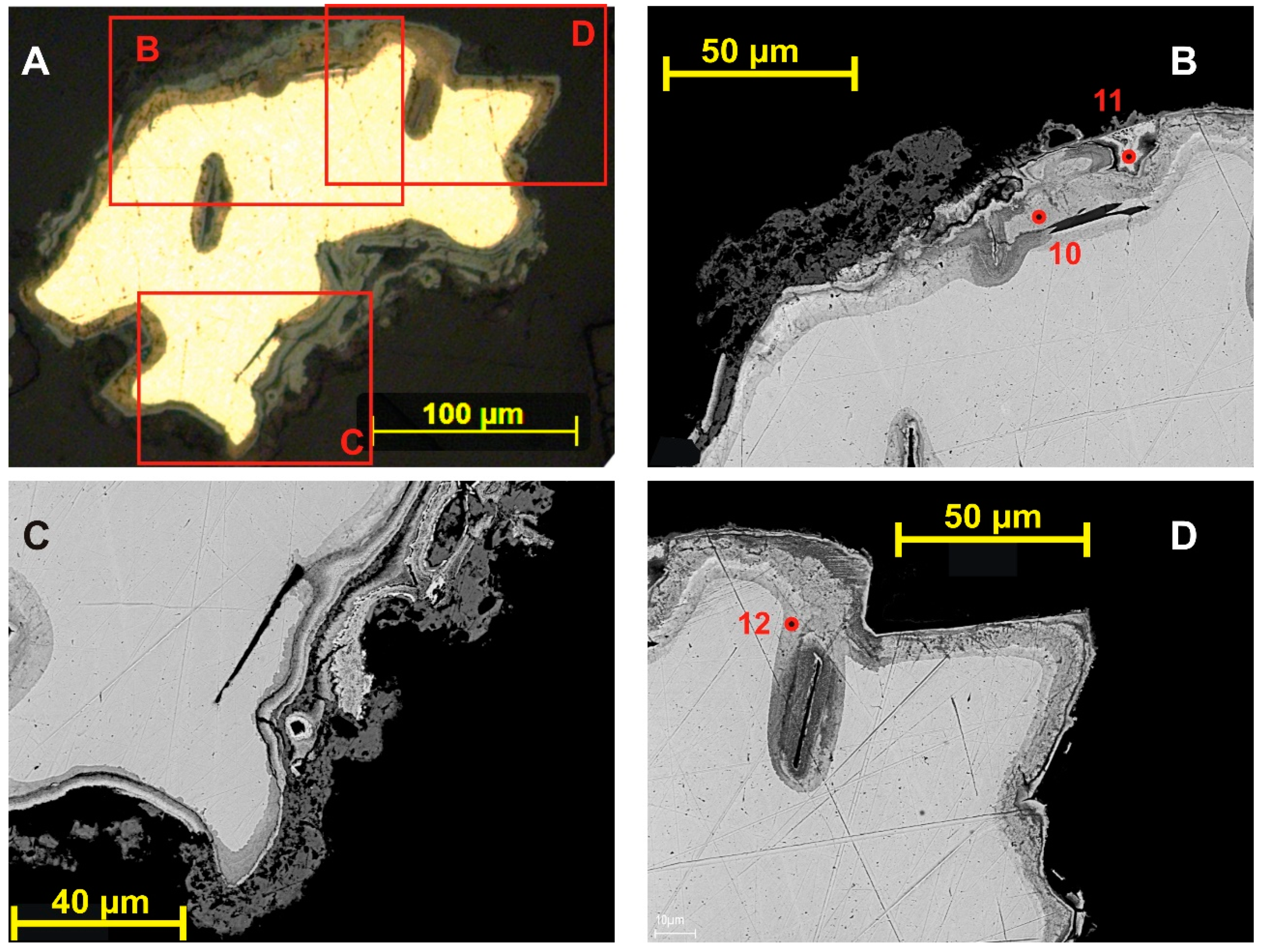
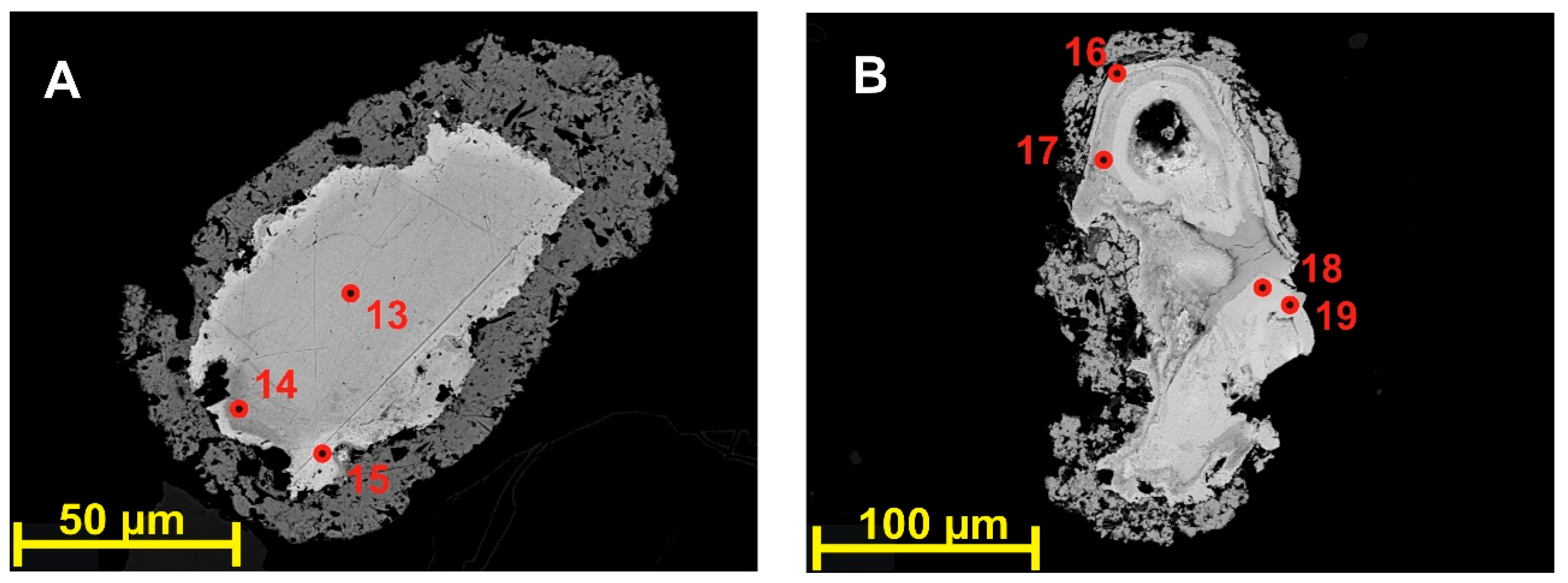
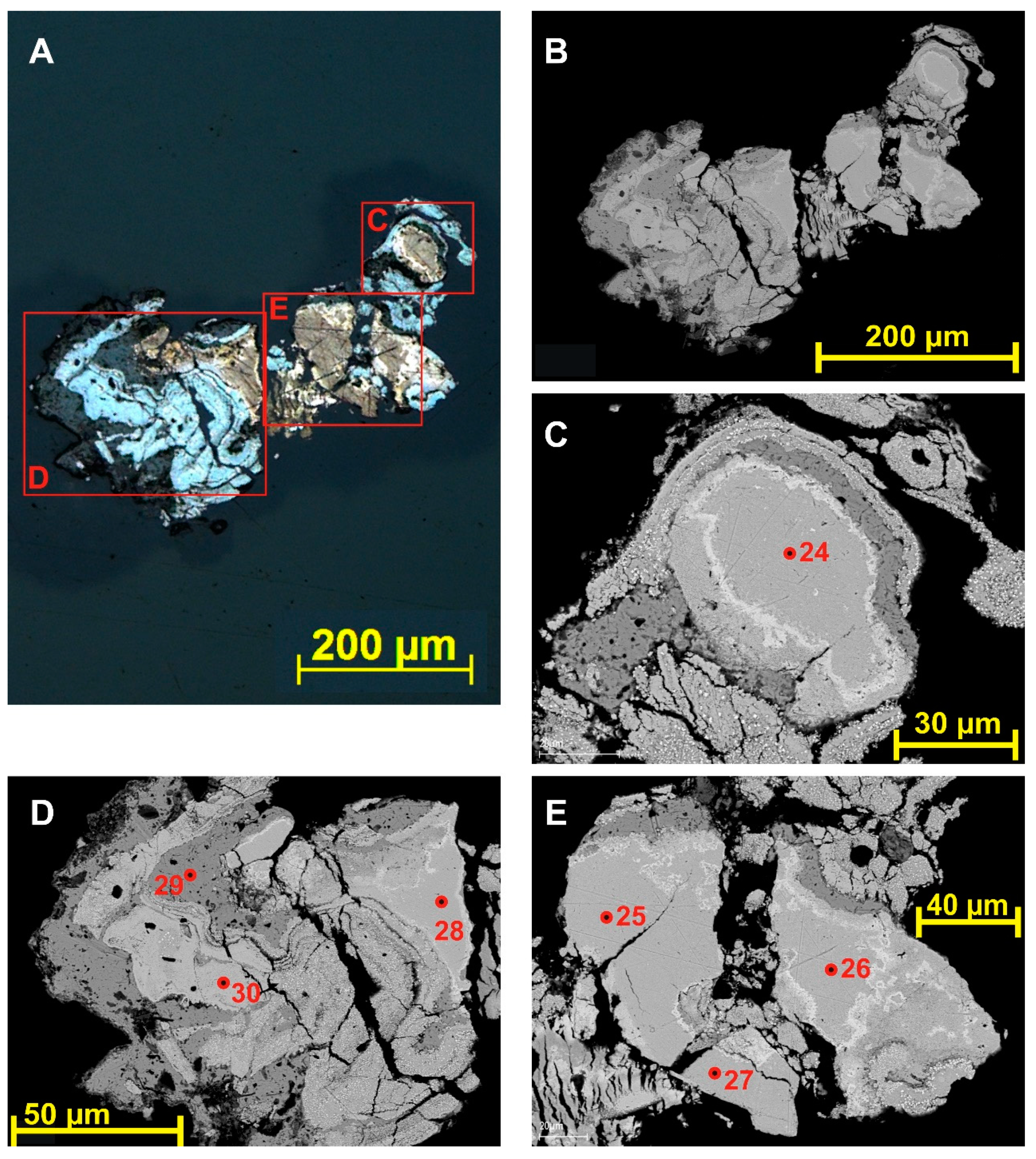
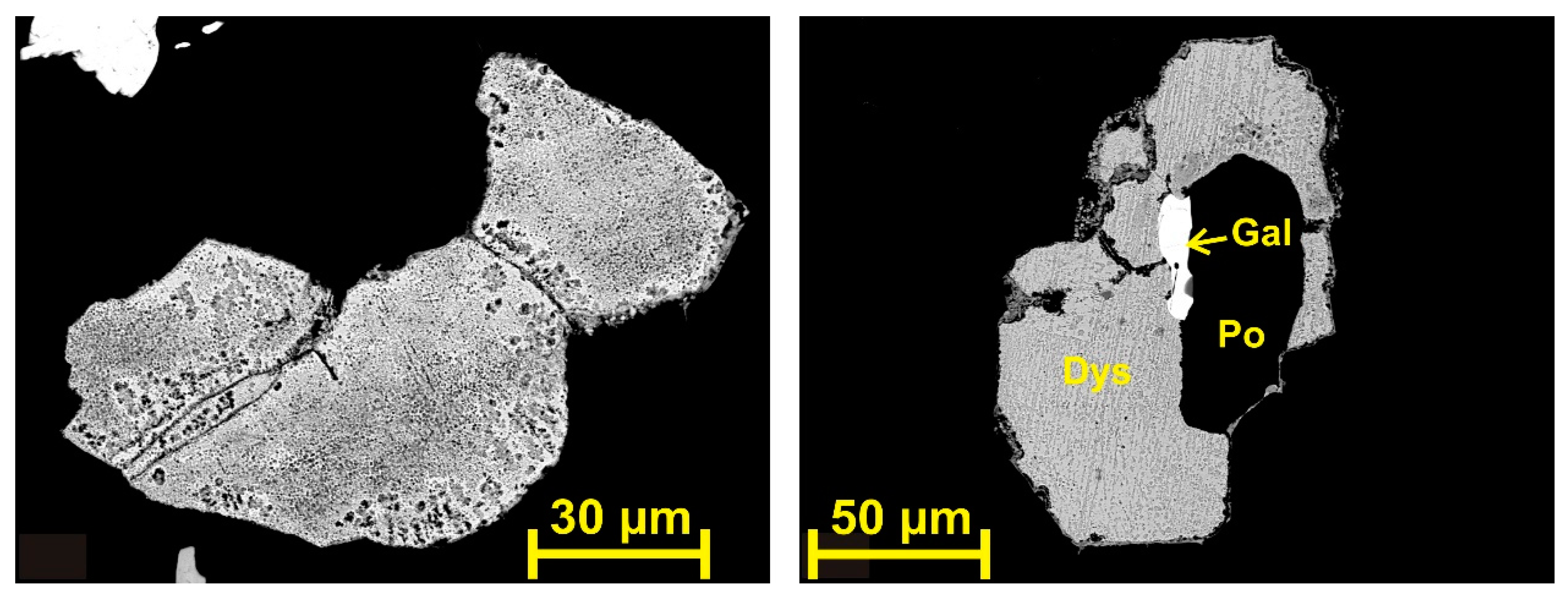
| Point # | 1 | 2 | 3 | 4 | 5 | 6 | 7 | 8 | 9 | Point # | 10 | 11 | 12 | 13 | 14 | 15 | 16 | 17 | 18 | 19 |
|---|---|---|---|---|---|---|---|---|---|---|---|---|---|---|---|---|---|---|---|---|
| Mg | n.a. | n.a. | 0.18 | n.a. | n.a. | n.a. | n.a. | n.a. | n.a. | S | 0.42 | 7.67 | 1.33 | 1.07 | 1.28 | 0.71 | 8.84 | 4.52 | 0.48 | 0.53 |
| Si | n.a. | n.a. | 1.18 | n.a. | n.a. | n.a. | n.a. | n.a. | n.a. | Cl | 9.23 | 0.09 | 0.36 | 0.13 | 0.32 | 0.13 | 0.15 | 0.11 | 11.33 | 0.09 |
| S | n.a. | n.a. | 0.99 | n.a. | 0.44 | 0.76 | n.a. | 0.61 | 0.75 | Fe | 0.14 | 0.62 | n.a. | n.a. | n.a. | 0.47 | 1.33 | 0.68 | n.a. | n.a. |
| Cl | n.a. | n.a. | n.a. | n.a. | 0.05 | 0.08 | n.a. | 0.18 | 0.13 | As | n.a. | 1.22 | n.a. | n.a. | n.a. | 0.26 | 0.75 | 0.31 | n.a. | n.a. |
| Fe | n.a. | n.a. | 18.76 | n.a. | 0.34 | 3.20 | n.a. | 0.42 | 5.43 | Br | 0.59 | 0.41 | 3.29 | 5.74 | 2.13 | 1.40 | 1.19 | 1.78 | 0.67 | 14.56 |
| As | n.a. | n.a. | n.a. | n.a. | 0.21 | 2.00 | n.a. | 0.21 | 1.19 | Ag | 46.50 | 44.35 | 43.84 | 50.85 | 28.89 | 24.49 | 54.76 | 26.03 | 46.53 | 43.12 |
| Br | n.a. | n.a. | n.a. | n.a. | 2.46 | 3.42 | n.a. | 1.41 | 1.37 | Sb | n.a. | n.a. | 1.79 | 1.00 | 0.66 | 0.50 | n.a. | n.a. | n.a. | n.a. |
| Ag | 58.53 | 51.17 | 7.60 | 63.59 | 52.67 | 33.00 | 64.88 | 46.43 | 35.74 | Au | 30.24 | 31.54 | 43.72 | 28.44 | 54.30 | 59.77 | 22.42 | 53.02 | 29.16 | 30.90 |
| Sb | 2.60 | 1.60 | 17.23 | 2.30 | 1.87 | 0.76 | 1.68 | 0.85 | 0.88 | C | n.a. | n.a. | n.a. | n.a. | 3.64 | n.a. | n.a. | n.a. | n.a. | n.a. |
| Au | 27.84 | 35.32 | 21.97 | 23.76 | 33.46 | 47.97 | 25.73 | 40.35 | 45.17 | Total | 87.12 | 85.90 | 94.33 | 87.23 | 91.22 | 87.73 | 89.44 | 86.45 | 88.17 | 89.20 |
| Pb | n.a. | n.a. | 3.28 | n.a. | n.a. | n.a. | n.a. | n.a. | n.a. | |||||||||||
| Total | 88.97 | 88.09 | 71.29 * | 89.65 | 91.50 | 91.19 | 92.29 | 90.46 | 90.66 | |||||||||||
| Atomic quantities (%) | ||||||||||||||||||||
| Point # | 1 | 2 | 3 | 4 | 5 | 6 | 7 | 8 | 9 | Point # | 10 | 11 | 12 | 13 | 14 | 15 | 16 | 17 | 18 | 19 |
| Mg | n.a. | n.a. | 1.0 | n.a. | n.a. | n.a. | n.a. | n.a. | n.a. | S | 1.5 | 28.3 | 5.6 | 4.6 | 4.3 | 3.8 | 29.0 | 20.3 | 1.6 | 2.2 |
| Si | n.a. | n.a. | 5.5 | n.a. | n.a. | n.a. | n.a. | n.a. | n.a. | Cl | 30.0 | 0.3 | 1.4 | 0.5 | 1.0 | 0.6 | 0.4 | 0.4 | 34.7 | 0.3 |
| S | n.a. | n.a. | 4.1 | n.a. | 1.9 | 3.3 | n.a. | 2.7 | 3.2 | Fe | 0.3 | 1.3 | n.a. | n.a. | n.a. | 1.4 | 2.5 | 1.8 | n.a. | n.a. |
| Cl | n.a. | n.a. | n.a. | n.a. | 0.2 | 0.3 | n.a. | 0.7 | 0.5 | As | n.a. | 1.9 | n.a. | n.a. | n.a. | 0.6 | 1.1 | 0.6 | n.a. | n.a. |
| Fe | n.a. | n.a. | 44.2 | n.a. | 0.8 | 8.1 | n.a. | 1.1 | 13.4 | Br | 0.9 | 0.6 | 5.6 | 9.8 | 2.9 | 3.0 | 1.6 | 3.2 | 0.9 | 24.0 |
| As | n.a. | n.a. | n.a. | n.a. | 0.4 | 3.8 | n.a. | 0.4 | 2.2 | Ag | 49.7 | 48.6 | 55.2 | 64.3 | 28.9 | 38.5 | 53.4 | 34.8 | 46.8 | 52.7 |
| Br | n.a. | n.a. | n.a. | n.a. | 4.2 | 6.0 | n.a. | 2.5 | 2.4 | Sb | n.a. | n.a. | 2.0 | 1.1 | 0.6 | 0.7 | n.a. | n.a. | n.a. | n.a. |
| Ag | 76.9 | 71.1 | 9.3 | 80.9 | 67.0 | 43.2 | 80.6 | 62.0 | 45.7 | Au | 17.7 | 18.9 | 30.2 | 19.7 | 29.7 | 51.4 | 12.0 | 38.8 | 16.1 | 20.7 |
| Sb | 3.0 | 2.0 | 18.6 | 2.6 | 2.1 | 0.9 | 1.8 | 1.0 | 1.0 | C | n.a. | n.a. | n.a. | n.a. | 32.7 | n.a. | n.a. | n.a. | n.a. | n.a. |
| Au | 20.0 | 26.9 | 14.7 | 16.5 | 23.3 | 34.4 | 17.5 | 29.5 | 31.6 | |||||||||||
| Pb | n.a. | n.a. | 2.1 | n.a. | n.a. | n.a. | n.a. | n.a. | n.a. | |||||||||||
| Point # | 20 | 21 | 22 | 23 | 24 | 25 | 26 | 27 | 28 | 29 | 30 |
|---|---|---|---|---|---|---|---|---|---|---|---|
| S | n.a. | n.a. | n.a. | n.a. | 0.27 | 0.24 | 0.22 | 0.21 | 0.23 | 0.04 | 11.15 |
| Cl | n.a. | n.a. | n.a. | n.a. | 11.16 | 11.44 | 11.49 | 11.48 | 11.61 | 10.72 | 0.00 |
| Fe | 13.5 | 11.16 | 1.71 | 2.08 | 0.04 | 0.10 | 0.14 | 0.00 | 0.05 | 0.00 | 0.15 |
| Al | 0.19 | 0.21 | n.a. | n.a. | n.a. | n.a. | n.a. | n.a. | n.a. | n.a. | n.a. |
| Cu | n.a. | n.a. | 0.25 | 0.24 | n.a. | n.a. | n.a. | n.a. | n.a. | n.a. | n.a. |
| As | 1.16 | 1.26 | 0.61 | 0.74 | 0.13 | 0.00 | 0.00 | 0.00 | 0.00 | 0.00 | 0.00 |
| Ag | 0.81 | 0.52 | 12.22 | 10.38 | 49.90 | 47.38 | 49.15 | 48.11 | 47.37 | 81.49 | 59.86 |
| Sb | 0.11 | 0.18 | 0.42 | 0.32 | n.a. | n.a. | n.a. | n.a. | n.a. | n.a. | n.a. |
| Au | 66.27 | 72.33 | 73.19 | 65.88 | 38.51 | 36.45 | 35.72 | 37.39 | 36.25 | 1.20 | 26.88 |
| Tl | n.a. | n.a. | 5.02 | 6.34 | n.a. | n.a. | n.a. | n.a. | n.a. | n.a. | n.a. |
| Total | 82.04 | 85.66 | 93.43 | 85.97 | 100.00 | 95.60 | 96.72 | 97.20 | 95.51 | 93.45 | 98.04 |
| Atomic quantities (%) | |||||||||||
| S | n.a. | n.a. | n.a. | n.a. | 0.8 | 0.8 | 6.7 | 0.7 | 0.8 | 0.1 | 33.4 |
| Cl | n.a. | n.a. | n.a. | n.a. | 32.0 | 33.7 | 31.4 | 33.5 | 34.2 | 28.4 | 0.0 |
| Fe | 40.2 | 25.3 | 5.5 | 7.2 | 0.1 | 0.2 | 0.2 | 0.0 | 0.1 | 0.0 | 0.3 |
| Al | 1.2 | 1.0 | n.a. | n.a. | n.a. | n.a. | n.a. | n.a. | n.a. | n.a. | n.a. |
| Cu | n.a. | n.a. | 0.7 | 0.7 | n.a. | n.a. | n.a. | n.a. | n.a. | n.a. | n.a. |
| As | 2.6 | 25.3 | 1.5 | 1.9 | 0.2 | 0.0 | 0.0 | 0.0 | 0.0 | 0.0 | 0.0 |
| Ag | 1.2 | 2.1 | 20.4 | 18.7 | 47.0 | 45.9 | 44.1 | 46.2 | 45.8 | 70.9 | 53.3 |
| Sb | 0.2 | 0.6 | 0.6 | 0.5 | n.a. | n.a. | n.a. | n.a. | n.a. | n.a. | n.a. |
| Au | 55.9 | 46.6 | 66.9 | 64.9 | 19.9 | 19.4 | 17.5 | 19.7 | 19.2 | 0.6 | 13.1 |
| Tl | n.a. | n.a. | 4.4 | 6.0 | n.a. | n.a. | n.a. | n.a. | n.a. | n.a. | n.a. |
© 2019 by the authors. Licensee MDPI, Basel, Switzerland. This article is an open access article distributed under the terms and conditions of the Creative Commons Attribution (CC BY) license (http://creativecommons.org/licenses/by/4.0/).
Share and Cite
Kalinin, A.A.; Savchenko, Y.E.; Selivanova, E.A. Mustard Gold in the Oleninskoe Gold Deposit, Kolmozero–Voronya Greenstone Belt, Kola Peninsula, Russia. Minerals 2019, 9, 786. https://doi.org/10.3390/min9120786
Kalinin AA, Savchenko YE, Selivanova EA. Mustard Gold in the Oleninskoe Gold Deposit, Kolmozero–Voronya Greenstone Belt, Kola Peninsula, Russia. Minerals. 2019; 9(12):786. https://doi.org/10.3390/min9120786
Chicago/Turabian StyleKalinin, Arkadii A., Yevgeny E. Savchenko, and Ekaterina A. Selivanova. 2019. "Mustard Gold in the Oleninskoe Gold Deposit, Kolmozero–Voronya Greenstone Belt, Kola Peninsula, Russia" Minerals 9, no. 12: 786. https://doi.org/10.3390/min9120786
APA StyleKalinin, A. A., Savchenko, Y. E., & Selivanova, E. A. (2019). Mustard Gold in the Oleninskoe Gold Deposit, Kolmozero–Voronya Greenstone Belt, Kola Peninsula, Russia. Minerals, 9(12), 786. https://doi.org/10.3390/min9120786





